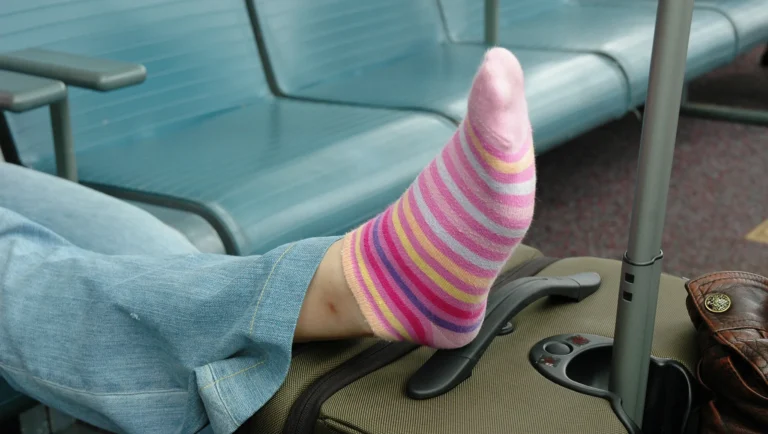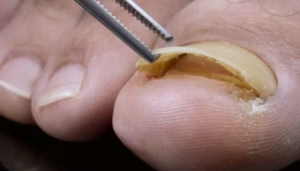Whether you’re jetting off on a long-haul adventure or hopping across the Tasman, you might have noticed your ankles puffing up after a flight. It’s not uncommon — in fact, swollen ankles after flying affect thousands of travellers every day. But why does it happen, and when should you be concerned?
At ModPod Podiatry, we often see patients who experience ankle or foot swelling linked to air travel. Let’s break down what’s going on, when to seek help, and how to keep your legs feeling light and healthy on your next flight.
Why Do Ankles Swell After Flying?
Swollen ankles after flying — medically known as dependent oedema — occur when fluid builds up in the lower legs and feet. The main culprit is prolonged sitting.
When you’re seated for long periods (especially in tight plane seats), your calf muscles don’t contract much. Normally, these muscles help pump blood and fluid back up towards your heart. Without that movement, circulation slows, allowing fluid to pool around your ankles and feet.
Combine that with cabin pressure changes, dehydration, and reduced oxygen levels in the cabin air, and your body retains even more fluid.
Other contributing factors include:
- Tight clothing or crossed legs restricting blood flow
- Warm cabin temperatures which dilate blood vessels
- High salt intake before or during the flight
- Hormonal changes (common in pregnancy)
- Pre-existing health issues, such as varicose veins or poor circulation
The longer the flight, the more likely your ankles will swell — especially on long-haul routes from Australia or New Zealand to Europe or the US.
Is It Dangerous?
For most people, mild swelling after flying is harmless and temporary. It usually settles within a few hours of moving around and rehydrating.
However, in some cases, it can signal something more serious. Persistent or painful swelling, especially if it affects one leg more than the other, could indicate a deep vein thrombosis (DVT) — a blood clot in the leg vein.
Symptoms that warrant medical attention include:
- Significant swelling or tightness in one leg
- Redness or warmth in the calf
- Sharp pain or tenderness
- Shortness of breath or chest pain (in rare cases if a clot travels to the lungs)
If you notice any of these symptoms after flying, seek urgent medical care.
Who Is Most at Risk?
Certain people are more prone to ankle swelling or DVT after flying, including:
- Those over 60 years old
- People with a history of blood clots or varicose veins
- Pregnant women
- Those with heart disease, diabetes, or circulation problems
- People who are overweight or inactive
- Travellers on flights longer than 4 hours
Even if you’re healthy, anyone can experience mild swelling after sitting still for too long — it’s your body’s way of saying it needs to move!
How to Prevent Swollen Ankles on Flights
Fortunately, a few simple steps can go a long way to prevent ankle swelling during air travel.
1. Keep Moving
Try to stand up and walk the aisle every hour or two. Even short strolls improve circulation and help prevent fluid build-up.
If you’re stuck in your seat, do some in-seat exercises:
- Flex and point your toes
- Circle your ankles
- Contract and relax your calf muscles
These movements act like a mini workout for your veins.
2. Wear Compression Socks
Graduated compression socks are one of the most effective tools for preventing swelling and DVT. They gently squeeze your calves, helping blood return to the heart.
At ModPod Podiatry, we can recommend medical-grade compression stockings that fit properly and provide the right pressure for your needs.
3. Stay Hydrated
Cabin air is very dry, which can thicken your blood slightly and slow circulation. Drink plenty of water throughout your flight and avoid excess alcohol or caffeine, which can dehydrate you.
4. Avoid Crossing Your Legs
Crossing your legs restricts venous return and can make swelling worse. Keep both feet flat on the floor when seated, or prop them slightly on a footrest if possible.
5. Dress Comfortably
Wear loose, breathable clothing that won’t constrict your waist, thighs, or calves. Tight jeans or stockings without proper compression can trap fluid in the lower legs.
6. Watch Your Salt Intake
Salty snacks or airline meals can increase water retention. Choose lighter options and balance your diet with fruits, nuts, and plenty of fluids.
7. Book an Aisle Seat
If you’re prone to swelling, an aisle seat makes it easier to get up and move around. A small choice like this can make a big difference on a long-haul flight.
What to Do If Your Ankles Are Swollen After Flying
If your ankles are swollen after landing, here’s how to ease the discomfort:
- Elevate your feet above heart level to help drain fluid
- Apply a cool compress or soak your feet in cool water
- Massage your calves and feet to stimulate circulation
- Stay active — walking helps move excess fluid out of your legs
- Wear compression socks for a few hours after landing
Swelling should subside within a day. If it doesn’t, or if pain or redness develops, book an appointment with your GP or podiatrist to rule out any underlying circulation issues.
When to See a Podiatrist
While travel-related swelling is usually temporary, recurring or persistent swelling can indicate deeper problems — such as chronic venous insufficiency, lymphoedema, or foot biomechanics issues.
At ModPod Podiatry, our experienced team can assess your circulation, gait, and overall leg health. We offer diagnostic tools, compression therapy advice, and tailored treatment plans to help prevent swelling and keep your legs healthy, whether you’re flying or on the ground.
The Bottom Line
Swollen ankles after flying are common, but they don’t have to be part of your travel routine. By staying active, hydrated, and mindful of your circulation, you can arrive at your destination feeling comfortable and energised.
If swelling becomes frequent or painful, don’t ignore it — your body may be signalling a circulation issue that needs attention. The team at ModPod Podiatry can help identify the cause and provide effective solutions so your next journey is smooth from take-off to touchdown.



